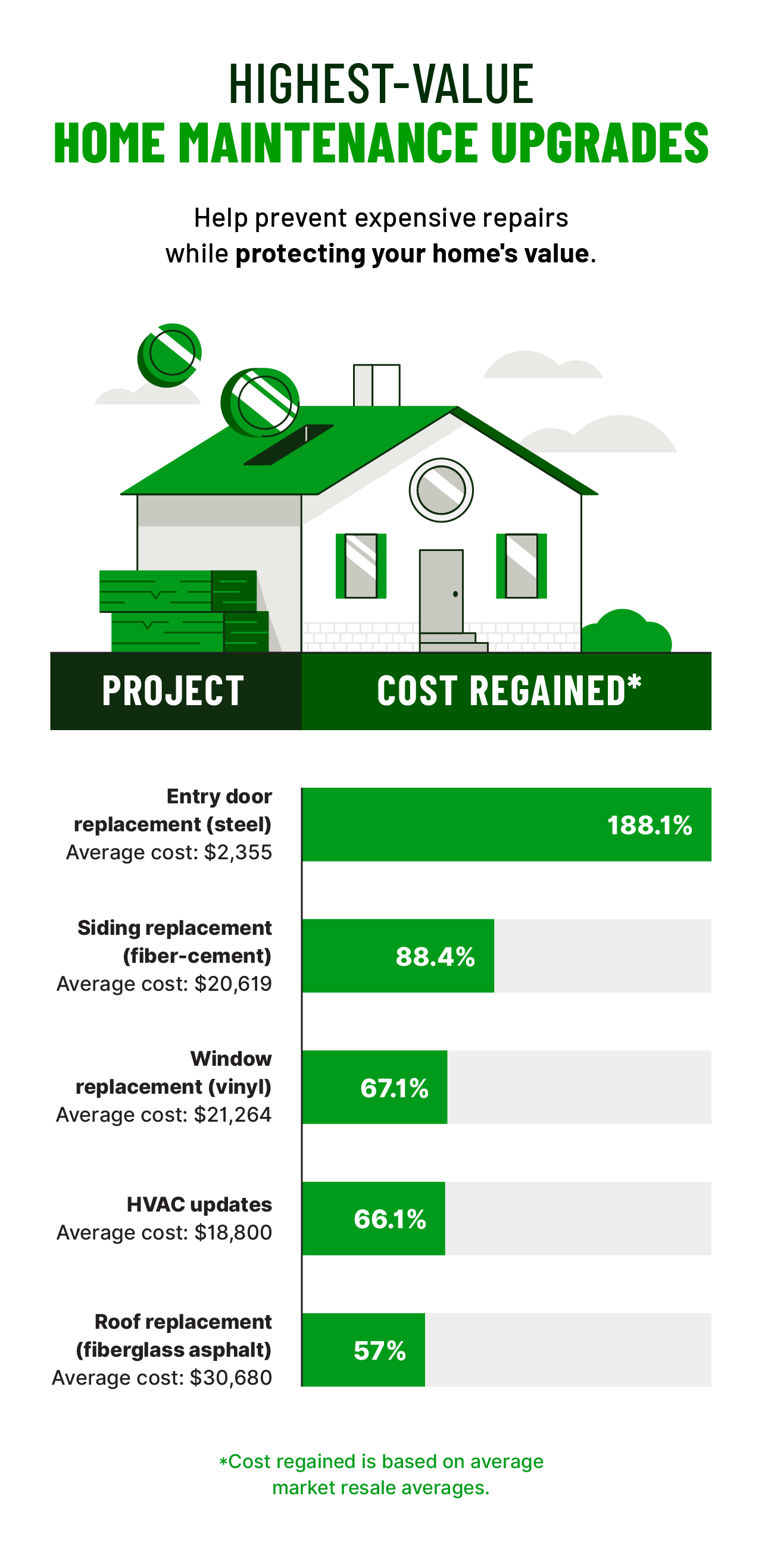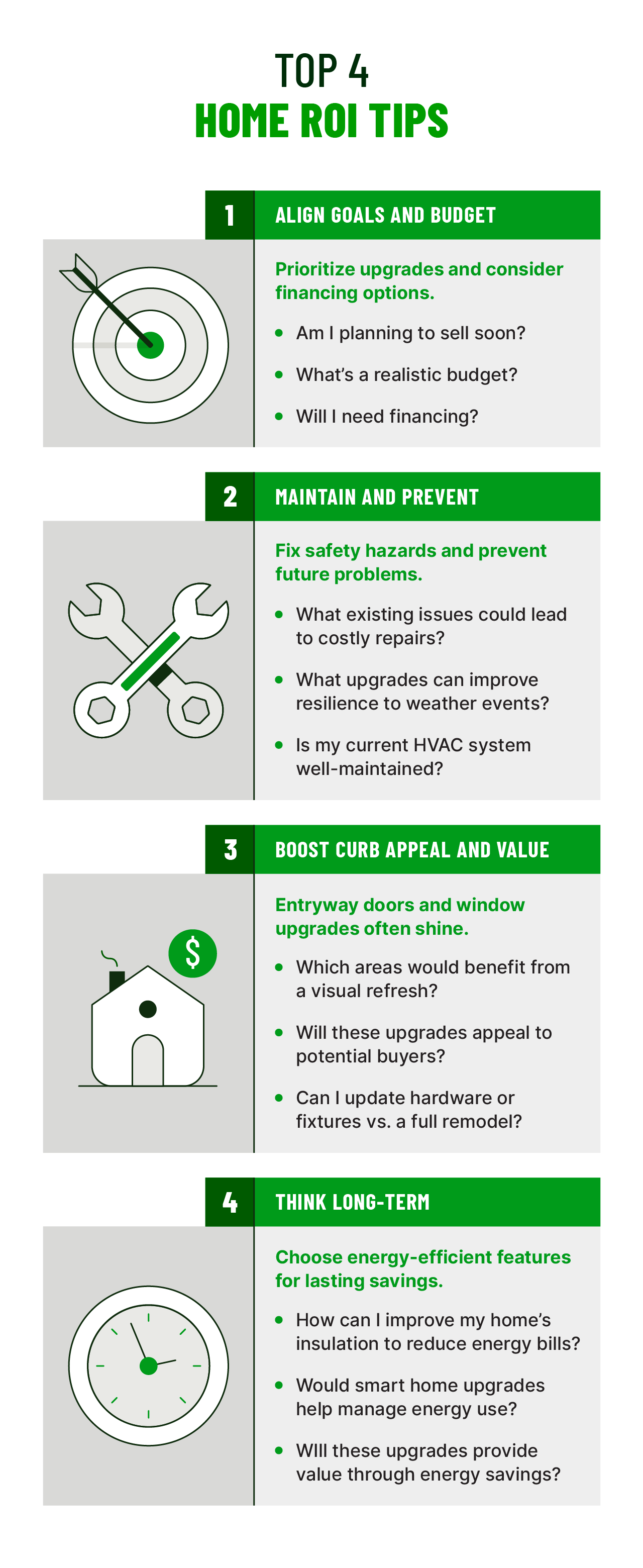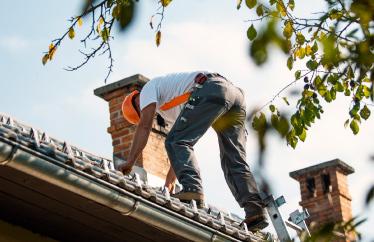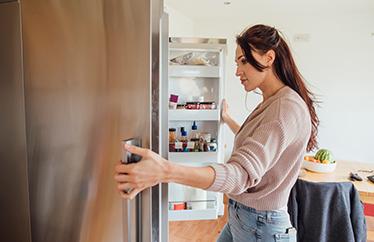Critical Home Maintenance Upgrades: 5 Best ROI Home Improvements in 2024

Staring at a list of home improvement projects can feel overwhelming when every project seems to promise a great return on investment (ROI). But what exactly does that mean, and which ones will give you the most bang for your buck (and sweat equity)?
In the world of home improvement, ROI refers to the financial return you get on your investment relative to the upfront costs. It can be calculated by dividing the net profit earned on an investment by the cost of an investment. When projecting the ROI of a home project, it’s important to consider factors such as market conditions, project costs, how long you plan to stay in a home, and your overall goals (such as whether you’re prioritizing resale value or personal enjoyment).
With 39% of homeowners citing home upgrades as their biggest concern in our 2023 Housepower report, it’s important to know that some home improvements offer a much higher ROI than others. This goes beyond just increasing your home's value when you sell. Maintenance-focused improvements can help save you money on utilities, prevent future repairs, and give you more peace of mind.
This guide will help you navigate high-value home improvements—with a focus on preventative maintenance to help you avoid future headaches. We’ll cover projects that increase long-term ROI potential, as well as lower-cost DIY projects with a short-term ROI, in case you’re looking to sell your home soon.
1. Entry door and window replacements
Whether you’re looking to upgrade to new doors and windows entirely or simply want to freshen things up before you sell your home, consider the long-term and short-term ROI upgrades below.
Short-term ROI
On average, U.S. homeowners earned back 188% of their investment from improving their entry door in 2024 based on market resale values. If you want to give your doors and windows an upgrade, consider the following improvements:
- Add a fresh coat of paint: A fresh coat of paint on your entry door can dramatically improve your home's curb appeal while also helping to protect it from the elements. Choose a color that complements your home's exterior, and consider a contrasting door color for added pop, such as Pantone’s color of the year for 2024, peach fuzz.
- Power wash windows: Power washing your window screens or hiring professional window cleaners can significantly improve the look of your windows, making your home appear more attractive to potential buyers.
- Replace weather-stripping: Cleaning up and replacing worn-out weather stripping around your doors and windows is a simple project that can help improve energy efficiency and reduce drafts. Consider adding door sweeps and window seals for further air infiltration reduction.
Long-term ROI
Average cost: $2,355 (steel entry door), $21,264 (vinyl windows)
Average resale value: $4,430(steel entry door), $14,270 (vinyl windows)
Effort: Moderate
Replacing your entry door and windows can be expensive, but it offers a high return on investment in several ways.
Upgrading your windows can also drastically improve the visual appeal of your home’s exterior. Based on average resale costs, homeowners earned back 67% of the upfront cost of replacing existing windows with new vinyl windows based on average resale values in the U.S.
Aside from the visual enhancements, these projects can also help address important home maintenance factors, including:
- Energy-saving benefits: Modern entry doors and windows often have superior insulation to older models. This translates to better temperature control throughout the year, reducing your reliance on heating and cooling systems.
- Improved security: Upgrading to a steel entry door with a multi-point locking system and impact-resistant windows can help deter break-in attempts. These improvements also provide a stronger physical barrier, making forced entry more difficult.
- Added protection from the elements: Extreme weather events can wreak havoc on your home. Steel entry doors are highly durable and can better withstand strong winds and hail. Modern vinyl windows can usually resist wind gusts and heavy rain, helping to prevent potential damage from water and the elements.
2. Smart home upgrades
Smart home features are becoming increasingly popular, and there are a range of small to large-scale upgrades that can add value and convenience to your home, depending on your short and long-term goals.
Short-term ROI
Even if you're not ready for a complete smart home overhaul, there are still ways to incorporate some smart features without breaking the bank. These short-term benefits include increased convenience, remote control of lights and appliances, potential energy savings, and a peace of mind from features like smart security cameras.
- Incorporate smart light bulbs: Smart light bulbs are a relatively inexpensive way to test the benefits of smart home features. You can control your lights remotely, create schedules, and potentially reduce your energy consumption.
- Install DIY smart security solutions: Consider installing smart door locks or doorbell cameras that you can monitor remotely using your smartphone. These features offer increased security for your home and peace of mind for potential buyers.
- Repurpose old devices: For an easy way to automate wired devices or appliances, consider using smart plugs. Some smart plugs only require WiFi to transform everyday lamps or appliances into smart devices. This allows you to control them remotely and potentially create schedules for added convenience.
Long-term ROI
Average cost: Varies
Average resale value: Varies
Effort: Low to moderate
Smart home technology can provide your home with comfort, security, and efficiency. It can also save you money in the long run by minimizing dangers like water damage. Here are some long-term smart home upgrades that can help prevent major repair expenses, providing indirect ROI opportunities:
- Smart sprinkler and irrigation systems: These systems use weather data and soil moisture sensors to automatically adjust watering schedules, preventing overwatering and wasted resources. Smart systems can help you reclaim this lost water and potentially reduce your water bill.
- Leak detectors and shutoff systems: The average cost of water damage repairs in the U.S. is around $2,700. Smart leak detectors can automatically shut off the water supply when leaks are detected, preventing costly water damage and potential repairs.
3. HVAC and ventilation system updates
The importance of a well-maintained HVAC system goes far. Whether you need to fully update your system for the long-term or just want some short-term improvements, consider the following options below.
Short-term ROI
Keeping your HVAC system well-maintained doesn't require a professional every time. Regular maintenance can improve air quality, potentially reduce energy costs, and make your home more appealing to buyers. Here are some simple DIY tasks to help improve air quality and potentially reduce energy costs.
- Change your filters: Regularly changing your air filters (every 1-3 months) improves air quality and system efficiency, potentially reducing your energy costs.
- Clean your vents: Schedule a professional cleaning for your HVAC system every 1-2 years. However, in the short term, you can vacuum around the unit and clean any accessible vents yourself.
- Seal any leaks: Inspect ductwork for any visible leaks or tears and seal them with foil tape. This can help improve system efficiency and potentially reduce energy bills.
Long-term ROI
Average cost: $18,800
Average resale value: $12,422
Effort: High
Upgrading your HVAC and ventilation system offers a significant return on investment by improving your home's safety depending on the age of your current unit, reducing energy costs, and enhancing indoor air quality. Based on average resale costs, switching from a low-efficiency gas furnace to an electric heat pump allowed homeowners to earn back 66% of the upfront replacement cost.
Heat pumps offer a trendy solution for eco-friendly living, aligning with the growing demand for renewable energy sources. Unlike traditional furnaces and air conditioners, heat pumps handle both heating and cooling needs, which can reduce your reliance on energy-hungry AC systems. This can translate to a positive impact on your wallet and the environment.
It’s important to note that electric heat pumps rely on extracting heat from the outside air, which can be less efficient in colder climates and may not be the right fit for every household. Compared to new construction homes, some older properties may not have the electrical capacity to handle an electric heat pump. If your home has natural gas and you live in a colder climate, a high-efficiency gas furnace is an alternative to consider.
When seeking a high-efficiency gas furnace, look for Energy Star-certified options. These certified furnaces meet the energy efficiency guidelines set by the U.S. Environmental Protection Agency and can offer energy cost savings. That could include an average of $30 in energy costs each year for homes in southern U.S. states and $80 per year in energy costs for the northern states.
Upgrading your HVAC and ventilation system can also help address important home maintenance factors, including:
- Enhanced safety: Replacing an outdated HVAC with a more modern system can minimize the risk of carbon monoxide leaks. Additionally, improved efficiency reduces strain on the system, lowering the chances of breakdowns and potential electrical fires.
- Improved efficiency: Focusing on improved ventilation during any furnace upgrade can potentially decrease your reliance on air conditioning. This ventilation boost helps to regulate temperature and further reduce energy consumption, allowing for more natural air circulation.
- Smart home integration: Many modern HVAC systems can be integrated with smart home technologies. This allows you to remotely control your heating and cooling system from your smartphone or other devices. You can set schedules, adjust temperatures, and monitor energy usage, all from the convenience of your phone.
4. Roof replacements
Whether you’re looking into a full roof replacement or just want to take advantage of some short-term solutions to extend the life of your existing roof, consider the options below.
Short-term ROI
A well-maintained roof can help increase your home’s curb appeal and prevent weather-related damage. Here are some steps you can take to ensure your roof is in great shape for potential buyers.
- Clean your gutters: Clean out your gutters regularly to help prevent pooling water from damaging your roof. This is a simple DIY task that can be done seasonally, and it helps contribute to increasing curb appeal.
- Repair damaged shingles: Inspect your roof for any loose or damaged shingles and attempt minor repairs yourself using roofing cement (for small areas). For larger repairs, consider hiring a professional roofer. Damaged roofs often get dinged during home inspections so minor repairs can go a long way if you’re considering selling your home.
- Trim overhanging branches: Trim back any tree branches that are overhanging your roof. This will prevent leaves and debris from accumulating on your roof and potentially causing problems, as well as boost curb appeal. Further, trimming back tree branches can help prevent potential damage that could occur during harsh storms.
Long-term ROI
Average cost: $30,680
Average resale value: $17,461
Effort: High
A new roof isn't just about aesthetics—it's a critical investment that can protect your home's value and ensure your family’s safety. While replacing your existing roof is no small undertaking, U.S. homeowners earned back 57% of their investment based on the latest market resale values after opting for a new roof with fiberglass asphalt shingles. Fiberglass shingles are a composite material that combines asphalt with fiberglass strands. This makes them more resistant to tearing and wind damage compared to traditional organic asphalt shingles.
Here's how a roof replacement can offer a high return on investment:
- Prevents damage: Your roof acts as your home's first line of defense against the elements. A new roof ensures a watertight barrier, preventing leaks and safeguarding your home from potential water damage. This, in turn, helps promote the structural integrity of your house, preventing costly repairs down the road.
- Fortifies a home: Newer roofing options such as metal roofs can also be a great choice for areas prone to hail storms, as they’re more resistant to hail damage compared to asphalt shingles. Metal roofs, slate roofs, and concrete tile roofs also offer superior fire resistance compared to traditional asphalt shingles.
- Curb appeal: A new roof with a clean and stylish look can significantly enhance your home's curb appeal. This translates to a potential boost in property value, especially if you're considering selling in the future.
Keep in mind that most roofs typically last roughly 25 years, depending on factors like climate and shingle quality. Signs it might be time to consider a roof replacement include the age of your roof, visible damage like cracked shingles or exposed underlayment, leaks in your attic, ceiling or walls, and daylight peeking through your roof deck (which indicates the underlayment or shingles are failing).
5. Siding repair and replacement
Whether you opt to completely overhaul your home’s siding or simply give it some attention with a few easy fixes, it can make a big difference in boosting curb appeal and protecting your home from harsh weather elements.
Short-term ROI
While a full siding replacement is a significant project, there are easy and affordable ways to refresh your existing siding and make it look its best. Refreshing your siding with a deep cleaning, painting, or minor repairs can make your home look fresh, new, and more attractive to potential buyers. This can increase your home's value if you're planning to sell.
- Give it a powerwash: Power washing your existing siding can remove dirt, grime, and cobwebs, instantly improving your home's curb appeal.
- Patch up problem areas: Your home’s siding is the first line of defense against the elements, protecting your interior from wind, rain, and extreme temperatures. For minor cracks or holes in your siding, use a patching compound specifically designed for your siding material.
- Caulk and seal gaps: Re-caulk any gaps around windows, doors, and other openings in your siding to prevent water infiltration and improve your home’s insulation.
Long-term ROI
Average cost: $20,619
Average resale value: $18,230
Effort: High
Investing in your home's exterior with new siding offers a double benefit: it enhances your home's visual appeal while also providing a significant return on investment. Thanks to increased durability and reduced maintenance costs (and based on average resale costs) homeowners earned back roughly 88.4% of their upfront investment after upgrading their siding with fiber cement, a versatile and low-maintenance material composed of cement, wood pulp, sand, and fibers.
Highly resistant to fire, rot, insect damage, and harsh weather conditions, fiber cement siding can last with minimal upkeep. Unlike wood siding, which requires regular staining or painting, fiber cement siding requires minimal maintenance. Occasional cleaning it with a hose is typically sufficient.
Here's why upgrading your siding is a smart choice among high ROI renovations:
- Durability: Traditional wood siding is more susceptible to fire, rot, and insect damage than fiber-cement siding. You won't need to worry about premature repairs or replacements due to weather or pest issues, saving you money and time.
- Weatherproof: Updated siding acts as a tough shield against the elements. Its superior weather resistance protects your home from rain, wind, and harsh sun, minimizing the risk of water damage and structural problems. This can translate to a more secure and healthy living environment for your family.

Considerations for choosing the best ROI projects
With home improvement projects, the sheer number of options available can easily overshadow the excitement of potential upgrades. But before diving headfirst into renovations, it's crucial to consider your unique circumstances and goals for your home, especially when prioritizing maintenance and maximizing return on investment.
Here are some key factors to keep in mind to ensure the projects you choose align with your lifestyle and contribute to a well-maintained home:
- Homeownership goals: Are you planning to sell your home soon? Renovations like entry doors and windows might be a good choice, as they tend to offer a high ROI and increase curb appeal. If you plan to stay put for a while, you might prioritize upgrades that enhance your comfort and promote long-term cost savings.
- Current home condition: Prioritize addressing essential repairs that fix safety hazards or prevent future problems. This might include roof repairs, HVAC upgrades, or updating doors and windows. A well-maintained home is not only safer but also holds its value better.
- Budget and financing: Be realistic about your home maintenance budget and explore financing options if needed. Remember, the initial cost isn't the only factor. Consider ongoing maintenance expense savings when calculating your ROI.

A well-maintained home is a secure investment. By strategically focusing on improvements that enhance your home's value, durability, and safety, you can reap the benefits of a high ROI while minimizing future risks.
For personalized guidance or to learn more about how we can support your homeownership journey, download our Hippo Home app for free from the App Store and Google Play.
YourHaus, Inc. (“Hippo Home”) is an affiliate of Hippo Insurance Services. Services (including all repair or maintenance services) provided to customers through affiliated and unaffiliated third-party contractors. Services provided by Hippo Home include speaking to a home care specialist, or providing repairs or maintenance either remotely or on site. Use of Hippo Home is subject to Hippo Home’s terms and conditions and privacy policies. Use of unaffiliated third-party vendors is subject to the terms of service provided by such third party. Hippo Insurance Services is not responsible for your use/non-use of Hippo Home or any service vendor. © YourHaus, Inc. 2024
Hippo Insurance Services ("Hippo") is a general agent for affiliated and non-affiliated insurance companies. Hippo is licensed as a property casualty insurance agency in all states in which products are offered. Availability and qualification for coverage, terms, rates, and discounts may vary by jurisdiction. We do not in any way imply that the materials on the site or products are available in jurisdictions in which we are not licensed to do business or that we are soliciting business in any such jurisdiction. Coverage under your insurance policy is subject to the terms and conditions of that policy. Coverage and coverage amounts selected are the decision of the buyer.
This guidance and advice is not error-proof and not applicable to every home. You are responsible for determining the proper course of action for your property and neither Hippo nor Hippo Home is responsible for any damages that occur as a result of any advice or guidance.



